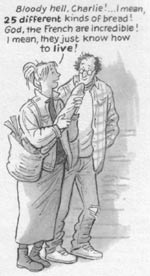Gemma BoveryMadame Bovary is a classic piece of French literature by Gustave Flaubert - the tragic story of a woman trapped in a marriage she barely values, who has a number of affairs and eventually does herself in. Simmonds's Gemma Bovery unashamedly takes elements from the life of Flaubert's similarly named protagonist, creating a modern-day tragedy of middle-class boredom. 
Simmonds's Bovery is an English woman who marries a man she isn't really in love with, but with whom she ends up moving to France to live in a cottage in a small village in Normandy. The story is told from the perspective of Raymond Joubert, a local French baker with a soft-spot for French literature, who starts to notice the parallels between the lives of Bovary and Bovery, and decides to try and halt the inevitable tragedy. 
Simmonds's characterisation is wonderful, with real, believable voices and expressive, distinctive faces, capable of showing a range of emotions throughout the book. Her soft wash style, not dissimilar to a monochrome Raymond Briggs, is charming and deceptively simple, allowing for quite complex layouts and great swathes of text. The usual layout traps that can trip readers who are unfamiliar to comics are not present though - something that was probably essential given that this was originally serialised in mainstream British newspaper The Guardian. Simmonds captures the ennui of the middle classes with style, though it can, at times, slip through into the plot. The conclusion is made plain from the beginning, while the main carriage of the plot is Joubert's progress through Bovary's diaries, partly trying to unearth what mystery is left about her death, but mostly in a slightly creepy voyeuristic manner. Occasionally, you just wish they'd all stop faffing about and get on with it. However, this is a literary, multi-layered work; a fine example of what can be achieved in the medium. As a result, it would make a great starting point for someone new to graphic novels, particularly if their current reading veers more towards the contemporary literary novel than the disposable trash you might pick up in an airport. Comment on this graphic novel review
|
Published byPantheon (US)
| |










